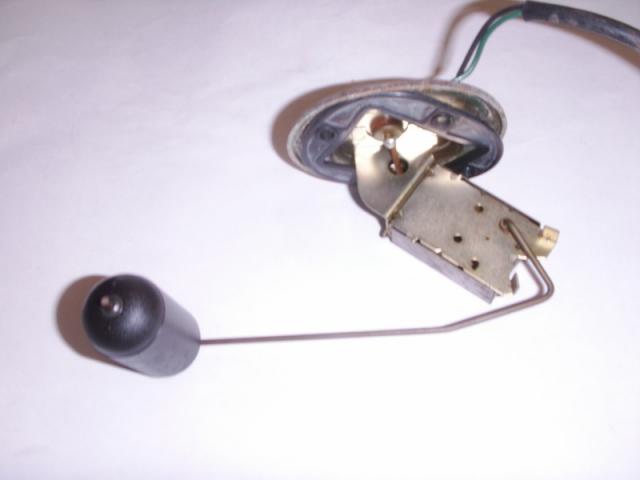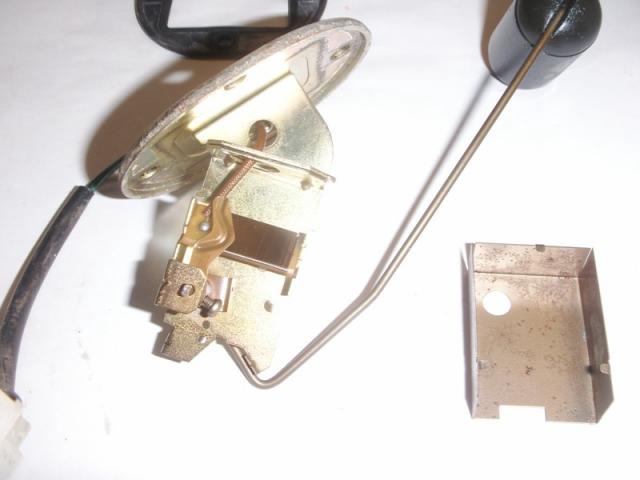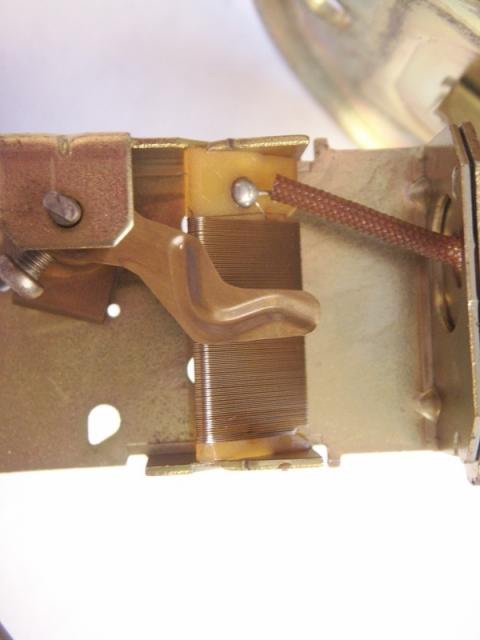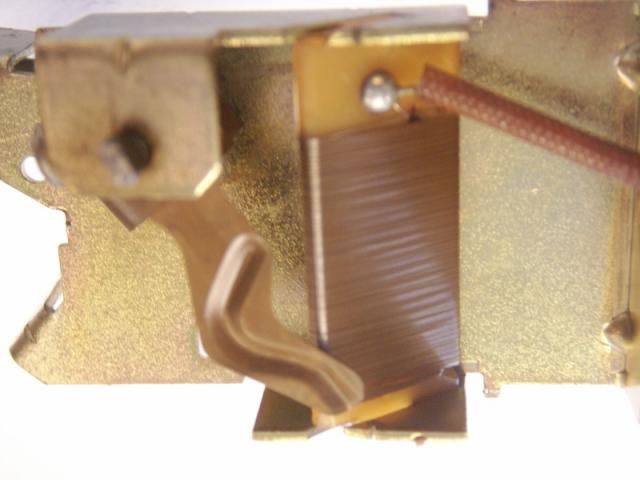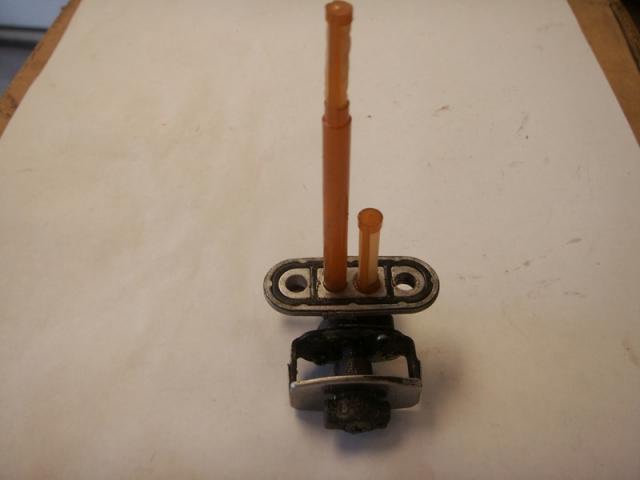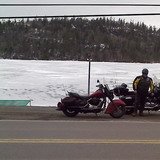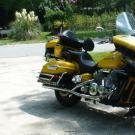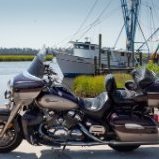Search the Community
Showing results for tags 'cover'.
-
I put an "I" basket in my scoot which quieted it down really well. Until I dragged (or is it drug?) my trailer 400 miles and then it got progressively louder, to the point where it may be louder than it was before the "I" basket. So, now I'm going to look at this from a different angle. Has anyone considered some type of sound deadening coating on the clutch cover to maybe lower the amount of transmitted whine? I'm still researching this, but I do know that what ever coating used would have to take a bit of heat as the side cover gets fairly warm. Maybe some of that pick up bed liner. I figured that I'd pick up a spare cover to play with from Ebay. Yesterday I was experimenting with sound deadening foam. I taped a large piece to the lower fairing area as there seems to be a lot of sound bouncing from that area with no luck. No matter how much foam I taped or wrapped around the right side of the bike, it stayed just as whiney. Now to the next idea. I have my old "G" basket and I'm toying with the thought of having the teeth on this basket "machined" slightly. Maybe a small grove cut in the center of the teeth of the primary driver gear would change things enough to lower the whine. Or possibly a slight radius to the top of the teeth. Anybody with a metal working background have any thoughts on any of this? I'm going to stop and talk to the local high performance engine builder on Thursday to see what they say. Thoughts?
-
A few posts have been made in the past about the workings of the fuel tank level sender & the petcock. I pulled these parts out of my spare gas tank and took some pictures of them to show how they work for interested members Picture of the sender unit as it came out of the tank. Picture of sender with metal cover removed. The tabs do not have to be bent to remove metal cover. Just spring sides of cover out slightly and cover will slide back. Close up of the wire wound resistor. The metal wiper contact is at middle position in photo. In this view float is all the way down, at the empty position, metal slider contact is now positioned at bottom of wire wound resistor. View of petcock showing adjust lever. View showing the two screens that go into to the tank. The longer pickup tube is for the regular selection. The shorter tube is for the reserve side. Gary
-
Ok, I hope someone has a quick / easier / inexpensive fix for this one.. Because I park the bike in the garage over night with the key in the ignition, and seldom stop longer than a fuel stop when traveling, I just noticed that when I pull the key out, the little cover jobbie doesn't cover up the hole that the key fits into.. So if left out over night, and it rains, I'm going to be heading for some problems with rust and such and be out of an ignition switch / lock.. I've sprayed it with WD40 and other products but can't seem to make it move to cover the hole.. Thoughts, suggestions?
-
I read several threads on mounting a garage door opener on the RSV and newer RSTD's. None of them were on the older RSTD's. So here is what I did. http://images.photos1.walmart.com/232323232%7Ffp432%3C9%3Enu%3D33%3B6%3E%3A%3B9%3E238%3EWSNRCG%3D32%3C483%3B958329nu0mrj First I opened up the remote an soldered wires to the activation button. When the cover is closed, the wires come through the whole in the front of the cover. You might have to create one on your remote. http://images.photos1.walmart.com/232323232%7Ffp43332%3Enu%3D33%3B6%3E%3A%3B9%3E238%3EWSNRCG%3D32%3C4843753329nu0mrj Then I found a suitable location for the remote button. I decided that behind the seat near the ignition switch was easy to get at, out of the way, and had plenty of room to work with. http://images.photos1.walmart.com/232323232%7Ffp432%3B6%3Enu%3D33%3B6%3E%3A%3B9%3E238%3EWSNRCG%3D32%3C4843756329nu0mrj I wired a momentary button from Radio Shack ($2.39) and heat shrinked the wires. Make sure the switch is "N O" (normally open) so it only activates when you press the button. http://images.photos1.walmart.com/232323232%7Ffp43335%3Enu%3D33%3B6%3E%3A%3B9%3E238%3EWSNRCG%3D32%3C483%3B959329nu0mrj Next I removed the drivers seat and drilled a hole for the button. Mine needed to be 3/8". http://images.photos1.walmart.com/232323232%7Ffp432%3B%3A%3Enu%3D33%3B6%3E%3A%3B9%3E238%3EWSNRCG%3D32%3C484374%3B329nu0mrj I installed the button. http://images.photos1.walmart.com/232323232%7Ffp43333%3Enu%3D33%3B6%3E%3A%3B9%3E238%3EWSNRCG%3D32%3C4843754329nu0mrj I removed the right side cover and had to relocate the relay from the center mount to the back one to make room for the remote. http://images.photos1.walmart.com/232323232%7Ffp43445%3Enu%3D33%3B6%3E%3A%3B9%3E238%3EWSNRCG%3D32%3C4843755329nu0mrj Relay now on the back mount. http://images.photos1.walmart.com/232323232%7Ffp43332%3Enu%3D33%3B6%3E%3A%3B9%3E238%3EWSNRCG%3D32%3C4846947329nu0mrj I used a zip tie to secure the remote to the two front mounts. Then I connected the button and the remote with bullet connectors to allow me to remove it if necessary for maintenance. http://images.photos1.walmart.com/232323232%7Ffp43453%3Enu%3D33%3B6%3E%3A%3B9%3E238%3EWSNRCG%3D32%3C4843757329nu0mrj Thats it! Simple, out of the way, easy to activate, and less than $3.00 out of my pocket.
-
Hi guys. I have a 1983 venture royale. I have all the bolts taken off the stator cover, but there is the gear shaft and its linkage that's stopping me from pulling the stator cover off. Two questions. How do you remove the gear shaft from back linkage/stator cover entirely? How can you just slide the stator off the bike leaving the gear shaft put? Please help. Thanks. (1st timer, I'm 27 w a 30+ year old bike.)
-
WARNING - this is LONG, so unless you are actually going to adjust your valves, or just like to read mechanical cookbooks, you probably should just stop here! There is a LOT involved in this job. It needs to be done, but it is probably worth whatever you local shop is charging. I'd certainly pay $200 for it if I trusted the shop, and I'm very comfortable doing the job myself. If you don't trust your shop, or don't have the money, then read on! We periodically have questions and discussions here on valve adjustments, like how often? (26,600 miles), is it really needed? (yes), how to? (read on), etc. And the tech manual, along with several other members, indicate it is a BIG job. So Ponch and I decided to organize a training session to see first-hand what was involved and find out about any surprises before we attempted to help any other members on this. And I want to really emphasize how thankful we are to BuddyRich for his wonderful loan of a shim kit and special tool, along with his selfless help of an entire day of hot sweaty work! Without him, what follows would probably never have happened: Background info: My 2005 RSV had the first valve check/adjustment done on schedule around 27,000 miles through the initial maintenance contract I purchased with the bike. Since the shop did it, I have no idea if any shim changes were actually needed, but since I saw evidence the valve cover gaskets were changed, I will assume that at the end of that service, all 16 valves were within spec. My bike now has 70,000 miles on it, putting it about 15,000 miles overdue for the second valve check. I found about half the valves either right at minimum tolerance or too tight (and three of them were significantly too tight). You get to decide how often you want to do your own bike, but I'll be doing this one by 30,000 miles each time now. Planning: 1. Order your gaskets and find tools and shims first. I wouldn't want to do this job without a valve shim kit unless I was willing to leave the bike torn down for several days to go find the right shims after measuring all the clearances. In addition, there are different ways to hold down the valve buckets to change the shims, but the only "right" way (and certainly the easiest) is to have the special tool; therefore, find or buy one before you start. The valve cover gasket is 4NK-11193-00-00, and the best price I found was at http://www.carolinacycle.com for about $18 ea. We have several members who have the tool and a shim kit (just a selection of various sizes) who may be willing to loan them. BuddyRich and Mother are two you might ask (if anyone else wants their name listed or removed here, please contact me so I can edit this post!). If you find someone to loan a shim kit, PLEASE ask them ahead of time to look at the current collection of shims, particularly the 265 and 270 sizes, to see if any common sizes are in short supply. The shims don't cost much, and in return for the loan, you really should buy at least two new shims in needed sizes before you start the job. Not only will this make it more likely you have the ones you need for your own bike, but it will make the kit better for the next use. It is hard to say ahead of time what sizes might be most needed, since every bike will change the mix. When we did four bikes on the same day, it was very interesting to see that. After the first two bikes, we had a ton of 270 shims, but not many 265 or 275. But after the next bike, there were only a couple 270s left but a big stack of 275. 2. This is a perfect time to change your coolant, so if you need it, have that on hand too. Even if you don't need to change it, you WILL need to drain about a quart, so have an appropriate clean tray and funnel that will allow you to do this and then add it back later. 3. This is also the perfect time to change your plugs, so have them on hand too. 4. Get a can of spray carb and choke cleaner. You are gonna want to pull those carbs (perfect time to set the floats too), and the #1 and #2 carbs are gonna be NASTY with oil residue and dirt. Legend has it that you can do this job without pulling the carbs, but no way I would want to try it. And besides, once you have all the other stuff off, pulling the carbs just isn't that hard. 5. You will really want to have your bike straight up for this job, so a center stand or maintenance jack is good to have on hand. This isn't required, but will be a lot easier and cleaner! On the side stand, you get some oil dumping off the left corner of the heads when you crack the valve cover loose, and more that comes out the covers in the left crank case. The oil mess is much worse if you have Leveling Links and you try this on the side stand! 6. Misc. tools: A good set of feeler gauges are obvious, but you will also need a torque wrench that goes down to 7.2 ft lbs (10 Nm or 86 in lbs), and a magnetic retrieving tool, tweezers or hemostats, and a good quality very small screwdriver (like a mid-size jeweler's driver, but stronger) will be necessary to remove the shims. I also recommend a tube of high temperature RTV 'gasket goo' to use on certain points of the new gaskets. On those feeler gauges, most sets have both inch and mm numbers, but the primary (or even increments) that it uses will be either inch or metric. You will have a much easier time of measuring and selecting shims if you have a metric set. And make certain you have a very bright flashlight - I prefer one of the new small LED ones because of the birghtness and color of the light. 7. Instructions - the shop manual is generally pretty good here, so I suggest you print out pages 3-9 through 3-13. The Job: Start by removing the basic stuff: seat, tank, lower cowlings, air filters. Since you WILL need to drain some coolant, just go ahead and pull those lower cowlings now and make taking off the air filters easier. Remove the "dog bones" connecting the front cylinder heads to the frame. Remove the air intake tract, including the rubber tubes where the air filters attach, the top air plenums, and the rubber T between the air filters (it is held on by one 10mm bolt on the right side of the frame). To get the air plenums off, you will need to first remove the metal straps on top (four screws each), and the two screws holding the crank case vent hose in the middle, then pull the hoses and wire bundles off to the side. After the clamps on top of each carb and the front clamp are loose, each plenum will just pull straight up. When taking off the metal straps, note that the inside front screw on each is longer than the other three, and be CAREFUL when putting all of those screws back at the end of this job - they will strip very easily! When you pull the crankcase breather connection loose from between the two air plenums, be careful of the little foam rings, most of them are stretched and falling apart - unfortunately they don't seem to be available in the parts breakdown. When you lift off each air plenum, there is a vent hose connected on the rear that will just pop off (watch out for the little wire spring clip - they aren't really necessary, but you don't want to have one pop off and get stuck in a carb or something). Pull all four plugs (necessary to turn the engine over while checking the valves). Drain the coolant - if not changing it, you will still need to drain a quart or so to allow the removal of the water hose from the rear head. CAUTION! The 12mm drain plug on the bottom left of the radiator is just plastic (as is the radiator), so when putting the plug back in, DO NOT OVER TIGHTEN!!!! The correct tightness is about what you can put on a clean, dry 3/8" socket extension with your bare hand. Pull the carb assembly. Start by disconnecting the fuel line behind the right rear carb and open the two clips on top of the carbs to release the fuel line that goes to the tank. Then disconnect the two overflow hoses that connect on top between the carbs and run forward to the front of the air filters. Go ahead and remove those overflow hoses completely, just pay attention to how they are routed and watch for the little plastic clip that holds them together between the carbs. At this point, all you need to do is loosen the hose clamp beneath each carb (but see the caution below) and disconnect the two electric plugs for the wires connected near the left front carb. You will find both of these plugs right up next to the frame under the large main wire bundle. The white two-wire plug is for the carb heaters, and the black triangular three-wire plug is the throttle position sensor. With the hose clamps below all four carbs loose, you can pull straight up on the assembly on each side to "pop" them loose from the intake manifolds (and this usually takes a lot of force!). With the carb assembly loose it slides straight out the left side. I generally wait until this point when the carbs are part way out to disconnect the throttle cables - access is much easier. Just loosen the long nut on each cable to allow it to slip off the bracket - as long as you don't move the small nut, the cables adjustment will not change. CAUTION! The screws on the hose clamps on the bottom of each carb are VERY soft metal. In addition, those clamps each have a metal collar to prevent you from over tightening them on the rubber boot. On most of the bikes I have worked on, at least one of those screws has been frozen so hard that the head stripped out, requiring me to drill it off to remove the clamp. If you have this same problem, stuff a rag under the clamp before you drill it off so you don't loose that little collar. The screw can then be replaced with any standard 4mm screw from the hardware store. With the carbs out, you probably should stuff a paper towel in each intake manifold to prevent anything from accidentally disappearing down there while you are working on the bike. Remove the chrome covers on the cylinder heads. Remove the plastic wire tray under the frame in front of the battery cover. This is held on by one 10mm bolt on the left side of the frame and a screw under all those hoses in front of the battery. Once that tray is off, pull the disconnected vent hoses out the back to get some needed working room above the rear valve cover. Finally, the last thing to take off before you can actually remove the valve covers is the rubber hose for the water line to the rear cylinder head (no need to take the front one off). You will need to remove the two plugs/covers in the center of the left crankcase cover to turn the engine, so now is a good time to do that. The two #3 philips-head screws are generally REAL tight, so make sure you use the correct size screwdriver to not bugger them. With the screws out, just use a very small screwdriver to work the cover back and forth on the O-ring to get it to pop off. There is a thin metal plate that will fall out as soon as the cover comes loose - it just goes back in with the ridge facing the crank, and you usually will not need to replace the O-rings on the covers. And now for the valve covers! Four flat allen-head bolts on each and they will pop off without too much effort. The gaskets are thick rubber, and they overlap a hollow cavity at the corner of each head. Just use your finger to pull of that rubber corner and then you can put a small screwdriver under there and catch the edge of the valve cover to pry it up. The rear cover will be difficult to get off, even after everything you have already removed! But just raise it as high as you can against the fuel line or other wire bundles still hanging below the frame and kinda rotate it forward to clear the cam chain. The front cover has lots of top clearance, but you need to take it out the right side to clear the water hose you left in place. FINALLY - ready to actually start checking valve clearance! MEASURING THE VALVE CLEARANCE: You can approach the measurement of the valve clearance two ways - some folks prefer to just turn the engine until they see the cam lobe pointing up for whatever valve they are checking, but I prefer to follow the more common practice of setting a piston at TDC on the compression stroke, then checking all valves for that cylinder (this is also the method from the service manual). But here is a little clue - don't get too hung up on believing everything in the service manual! There is a note in several places that tells you "TDC on the compression stroke can be found when the camshaft lobes are turned away from each other." NOT SO!!! While true for the front two cylinders, the cam lobes on the rear two cylinders will NEVER point away from each other! Seems weird to me, as I really expected the valve timing to show the identical relationship between the cams on all the cylinders for the same engine, but the facts show different. And before anyone asks, I did check my valve timing according to the manual and the index marks on the cams, and all four cams were correct. Anyway, back to the measurement. Start by turning the engine counterclockwise until you see the valves on #1 cylinder (left rear) all closed, then watch for the timing mark on the generator rotor through the observation hole to align with the mark on the crankcase cover. It is not necessary for it to be exactly perfect to measure the valves. Now you can check the clearance on both intake and both exhaust valves for #1. Since you are dealing with four valves at a time, it is helpful to write down the clearance you measure so you don't have to re-check them over and over again! If any valves need to be adjusted, I explain this in the next section. After completing the measurement and/or adjustment for #1, if you turn the crank 180 degrees, cylinder #3 (right rear) will be at TDC and ready to check (just put the socket on the crankshaft with the handle pointing to the rear and turn it counterclockwise until the handle points forward - can't get much easier than that!). When you are done with #3, turn the crank 180 degrees again, then start watching for a second timing mark to line up on the generator rotor 70 degrees later (a little less than 1/4 of a turn), now #2 is at TDC and ready to check. Finally, after checking/adjusting #2, just turn the crank 180 degrees one more time and #4 will be at TDC and ready to check. When you are done with #4, turning the crank just 110 degrees (slightly more than 1/4 turn) puts #1 back at TDC to start over. After you have made adjustments to any valve, I strongly recommend you turn the engine through several turns to ensure the valve shims are fully seated and measure them again to see if the final clearance is what you want. I found I needed to change the shims several times on some valves to get it right. By going through the 1, 3, 2, 4 sequence several times you get the chance to double-check all your measurements, as well as re-check the ones you changed. CHANGING THE VALVE CLEARANCE: Note: You will find a second person to help turn the engine VERY helpful here, especially when working on #3 and #4! To adjust the clearance you need to remove the existing shim and replace it with one of a more appropriate thickness. The majority of changes will be to a thinner shim, but you won't have any idea what the needed size will be until you get the existing shim out. Getting the tappet adjusting tool inserted the first time can be a little tricky. It can be inserted from either side of the cam, depending on which side you want to pull the shim from. The first thing you do is turn the crank in either direction so that the cam lobe is pointing AWAY from the side where you plan to insert the tool. Next, before you insert the tool, use your fingertip to turn both shim buckets until one of the open notches is where you can reach it with your small screwdriver - this is where you will need to pry up the old shim to break the suction of the oil film (and that can be tough to do). To insert the tool, try to rotate the short end under the cam to depress the buckets. You won't get it very far just with your fingers, so slowly turn the crank in the proper direction to let the cam finish turning the tool into place (while keeping some pressure on the long arm of the tool to make it move). You will want to make sure the tool is turned all the way until the long arm touches the side of the head or you won't have enough clearance to pull out the old shim. Now that the tool is in place, reach in with that little screwdriver and pry up on the bottom edge of the shim - the suction of the oil film will be STRONG, so don't be surprised if you have a tough time getting each shim to pop up. Once it does pop up, you can either grab it with tweezers or a magnet to pull it out. Turn it over and note the number on the bottom (they should always be installed with the number down). Replacement shims are only available in .05mm increments (such as 260, 265, and 270), but the ones you pull out might be be anything (such as 269 or 272). That is why you will find some odd numbers in the shim kit - they came out of someone else's bike. To decide what shim to put back in, you need to know what the clearance was before you removed it (remember, I said to write it down)! The shop manual has a really neat chart that lets you just look along one axis to find the number on your current shim, then just look down the side to find the clearance you measured - where the two lines intersect, that is the new shim number you need. It works pretty good, but make sure you look at the right chart (they are different for intake and exhaust)! If you try and do this job without having a shim kit, those charts are really the best way to decide which shims you need to buy. A less formal but more natural way is to just look at the number of the current shim, think about how much you need to change it (was that valve just a little tight, or a lot tight?), and then choose a slightly thinner or thicker shim that you think might be in the ballpark. For example, if you pull out a 273 shim and the valve was just a tad too tight, you might want to try a 270, but if it seemed quite a bit lower than the minimum spec, better go straight to the 265. No matter how you selected the new shim size, it is very important to turn the engine over several times and then re-check the clearance to see if your guess was correct - even using the charts leaves room for error. Putting it all back Together: Just a few notes here on reassembling the bike - most everything will just be a reverse of the disassembly process, but there are a few pointers to help you. Valve Cover Gaskets: These are very thick rubber with big half-circle "lumps" at the ends of each camshaft. They only go on ONE way. They are flat on the bottom, and the top has a ridge that fits into the groove on the valve cover. But it does not fit tight enough in the groove to hold it in place while you put the cover back. No matter, though, since there is not enough clearance to get the cover back on the rear cylinders with it attached - your only choice is to place the gasket on the head and then maneuver the cover in place. The original gasket seems to have been held to the cover by several spots of rubber cement in the groove, but there was no sign that a gasket sealant was used all the way around. Other than those glue spots on the cover, there was no sign that the original factory gasket had any RTV type gasket sealant used at all during assembly. However, when the shop did my valves the first time, they DID use a bit of RTV, but only on the lumps, and neither gasket ever leaked in 40,000 miles. For comparison, one person who had replaced the gasket without using any sealant did develop a slight leak at one of those lumps over time. For these reasons, I personally recommend applying just a thin coat of high temperature RTV to the depression in the head where those lumps fit before putting the gasket in place. Now look closely at the parts of the gasket where it is next to the spark plugs - on the exhaust side only you will see a slight squiggle or wave in the gasket, and on the cylinder head you will see a matching wave. Make sure you position the gasket with those points matching. Then look at the cover - notice the same wave? Guess where it goes . . . When you lower the cover down on the gasket, the challenge is to get the ridge on the gasket to smoothly fit up into the groove on the cover all the way around. If you even have a hint that the cover is not completely smooth and flush on the head, then the gasket is NOT completely seated in that groove. Take your time and trace the entire edge with a bright flashlight to get it right. Remember how much work it was to get that cover off; you don't want to have to do it again! When putting the front gasket and cover in place, remember they must go in from the right side to fit around that water pipe. The torque on the cover bolts is only 7.2 ft lbs., and that is not much. Make sure you have a wrench that has a setting that low, and use it. These are not the kind of gaskets where you can go back later and tighten them a little more if you get a leak. In fact, over tightening the cover on that thick rubber will just distort it and make the leak worse. Although the manual does not say to tighten the bolts from the inside out in a cross pattern like you would the head bolts, that is still the method I recommend. Air Intake Parts: Make sure you get that front T in place before you put the carbs in, same with the rubber Y that connects the air plenums to the T. The only thing to remember about the T is that it has a locating lug sticking out the front that MUST fit in the rubber grommet in the frame. The hose clamp on that rubber Y is located on the left side of the bike, with the head facing up. Initially it seems impossible to access, but just use a long screwdriver behind the wire bundles next to the frame. Putting the carbs back in: After making sure the hose clamps are still properly positioned on the top of the intake manifolds, slide the carbs in from the left side, but leave them just far enough out to make it easy to attach the throttle cables. Then after making sure all the carbs are centered on the manifolds, you need to push down on them pretty hard to pop them back in place. Try to put the base of your hand on top of the carb throats, not on the plastic diaphragm covers. Re-route all the fuel lines and vent hoses appropriately, and don't forget to re-connect the two plugs. Putting on the air plenums: Some people have had real trouble getting the air plenums to fit properly back on top of the carbs (and stay there when they tighten the clamps). In every single case I have seen, this has been caused by the rubber neck on the plenum being caught on the edge of the carb and buckled under the clamp - usually behind the carb where it is impossible to see. Make sure the clamps are plenty loose and rock the plenum a bit when putting it on. If the rubber is not buckled in there, the plenum will fit fully down on the carbs and not spring back up at all. Unlike the lower hose clamps, those on top of the carbs do not have a metal collar to prevent them from being over tightened, so just make sure they are properly set in the grooves on the plenum and snug them up pretty good instead of trying to play Magilla. I think that is about it. Let me know if you think I have missed something or you have any questions! Goose
-
I have oil collecting at the top of the left rear cylinder just below the chrome cover. I thought it was only occurring while running, but the bike has been sitting in the garage since Dec. 7th at which time I cleaned it thoroughly. While installing a Speed Bleeder and changing my clutch fluid over the weekend, I found oil there again. On the car I'd suspect a valve cover gasket. Do I have a valve cover gasket or similar on my RSV? Suggestions welcome. Ken
-
Hey everyone! I need some help. I got my '86 Yamaha Venture Royale about 18 months ago. It came with nice floorboards and a heel toe shifter. I figured this was standard equipment. About a week ago, I started home from work and to my dismay, I could only shift into first, neutral and second. I babied it along sidestreets and took my time driving 5 miles. Three more stops, I could only get first and neutral to work. To shorten this story, I discovered that the fitting on the left crankcase cover had broken. Reading on here, I discovered that I could get it welded because the casing is aluminum. I then took to working on removing the left crankcase cover. I have read the service manual, the repair manual and all I could find to get help on removing the left crankcase cover. After getting all the bolts off and discovering other things I need to remove, I found that there are two sets of wires that come from the back of the cover and goes to the flywheel assembly connected inside the crankcase cover. Here are my questions. 1. Do I need to removed the copper coils, the 4-5 screws holding everything in to disconnect the two sets of wires? ( I ask this because the philips screws are tight and I really don't want to remove this if possible so I won't have problems later matching to the flywheel. 2. Is there a simpler way to disconnect the two sets of wires without removing the screws and coils? 3. Is there a diagram somewhere that shows how to disconnect this? (The manual says to remove the electrical connectors like it is a simple switch) 4. Finally, is there much danger of warping or causing some damage to the inner electronics if I leave them inside? (I don't think there is, but maybe someone will have a horror story to change my mind!) I appreciate any help given and hope someone is smarter than I am figuring out how to get this off the bike so I can get it welded. Happy Thanksgiving!
-
Last year a member asked me to help fix his bike, turned out that water had got into the motor and it was ceased. He picked it up and has it parked since then under cover. It's been a few years since it has been used. He wants to donate it to somebody deserving. Let me know if you're interested. It's in Georgetown Ontario
-
Something like this? http://www.motorcyclenews.com/upload/271405/images/golf-rack.jpg I want to build on that doesn't cover the brakelight/license plate. Possibly off to the side of the saddle bag.
- 25 replies
-
- brakelight/license
- build
-
(and 3 more)
Tagged with:
-
I know it says Honda but should probably work on other bikes. http://www.addonaccessories.net/shop_details.asp?cat=%2DGL1800+%2A%2ANew%2A%2A&prod=%2A%2ANEW%2A+SIDE+COVER+REPAIR+STUDS+2011
-
My RSV has a coolant leak, under the left aft cyclinder cover. It is not coming from the cover bolt holes, but what I think is the cylinder drain plug (looks like #1 in the center picture on page 3-35 of the service manual). This 'plug' has no internal or external wrenching feature, but the center is threaded. Can I tighten this plug to try to stop the leak? How do I tighten it? Can I just thread another bolt in there to tighten it? Or will tightening the cylinder covers push it in to hold it? The bottom cylinder cover bolt was loose when I disassembled it.
-
Hi everybody, Just installed my new custom radiator cover by one of our own fine meber venders,[steve Wagner]. If you dont have one of these on your RSV, you have to check it out. Best money I have spent to date on making my 99 look better. Always hated that bare old radiator look. This custom fab fiberglass paintrd to match is awsome. Installs in seconds and looks super expensive.
-
Bought this bike about a week and a half ago. It was a pathetic, ugly, dirty mess. The windshield was so swirly, I had to look over it on the way home. My wife and I spent about 30 hours disassembling, cleaning, waxing and reassembling. Took it for inspection and the mechanic was impressed at how complete the bike was; all the parts are there. I still have detailing to do on the engine, clutch cover, etc, but it's not too bad. It runs like a top- I call it The Cruise Missile. The more I ride it, the more I like it. Amazing how light all that weight can seem when in motion. http://i275.photobucket.com/albums/jj290/cyprinut/1985%20Venture%20Royale/finished2.jpg
-
A gell seat cushion made for autos at Wall-mart for $19.96. Yes gell seat covers are sold for $100.00 or more with the sheep skin cover just for bikes. If I could find just a sheep skin cover now to go over the geel pad, I would be in high cotton..... I hear that it works fine for our bikes from another rider here about two days ago. I found one at the local store here and I am going to go pick it up. The first store was sold out and the next store only had one, so they put it back for me. Evidently they are popular. I am driving the car to get because wifey wants to go to dress store and drive car. So I will give update later on the true effects of the pad. Right at this moment I am in somewhat of pain from a ride the last two days, about 725 mile total. Not to bad but need a little extra something in the seat. I did the Rick Butler seat mod and it is nice, but still need a little something else, and I am not getting any younger. If this works out, this will be a good seat cover for a whole lot less money. More money for gas to ride.... :mo money: Fuzzy
-
Just got back from a trip that I had to don the rain suit 4 out of 4 days of riding. 3 of the days was not bad an hour maybe 2. Anyways the last day I just rolled the suit, and boots up and bungied them to the trunk rack as it was easier. When I got home I noticed that the heel of my rain boot has a tear in it. The ones I have now are maybe 5 yr old so close to replacement. They are the "spyder" type that have a complete sole. I am thinking about the Tourmaster or Nelson Rigg type. The cover just the toe and the heel is open. Can anyone tell me do these keep your feet dry with the heel being open? Are they a good rain cover? Looked at the Hopnel rain gaiters but the couple reviews didnt seem like the folks were very happy about the fastening methiod.
-
Do you have to drain the oil first before you take the cover off?
-
Correct me if I am wrong (not everyone at once), but don't we have someone on this forum that has the valve cover gaskets, and valve shim kit, that...if I buy the valve cover gaskets from them, they allow me to use the shim kit ??? This is for my '06 RSMTD.
-
I am wondering if anybody who has a a Corbin also has a sheepskin cover? I have been looking but haven't found anything.
-
I'm looking at a Nelson-Rigg Trike Cover #TRK-350 on E-bay. Will this cover properly fit the RS Venture with the Hannigan trike kit? Are any of you using this cover? Or is there a better suggestion? Thank You! Owen.
-
Stator went out on my awhile back so I have to replace it, got down to the bolt that holds the retaining cover for the stator wire going out of the case and snap off came the head. So I think ok I will drill it and use and easy out nope broke the stupid easy out in the middle of the bolt. I had thought about drilling to the side of it, tapping it and putting in a smaller bolt but I guess I really should just get a new side cover. Any thoughts , ideas or just plain jabs for my stupidity are Welcome. I am hoping I can find someone parting out an engine or has replaced one because it was scratched for cheap. Looks like a new one cost around 300 bucks.
-
Next weekend I'm puttin the bike away for her long winter's nap. It's going to be staying in a pole bar at my Uncle's place. I figure it would probably be a good idea to invest in a cover to keep dust off of it. I've got the 1300 RSTD, not sure if that's going to require a "Large" bike cover or an "XL" bike cover. Suggestions? Thanks
-
Going to visit my Grandkids in Illinois for Thanksgiving and I am considering renting a luxury Car or Minivan to make the 12 hour each way trip a little more comfortable (would ride but my daughter and her boyfriend are going too). I have never rented a car for pleasure so I have never had to deal with all the diffrent add ons. I have heard that my insurance will cover some damage and that credit cards will cover some items but I am not sure guess I should give them a call. The other thing is which rental companies do not charge per mile if you leave the area. Enterprise charges $.25 a mile if you are going further than the adjoining states. Any advice/tips are appriciated.



